The acronym SUV is inaccurate in the main because most such vehicles are utilitarian, and hardly sporty. Perhaps the ‘Sports’ bit relates to getting to sports fixtures in them. However, things are changing, particularly as SUVs are increasingly sharing monocoque platforms designed for cars. And performance is improving too.
Amongst the large SUVs that we have tested it took seemingly forever for one to break five-seconds for the 0-100km/h sprint, the RR Sport HSE amongst the first. And then, in over-the-top fashion, Porsche came along with its 2347kg Cayenne Turbo S which nonchalantly launched itself into the record books, posting 3.89sec, unlikely to be beaten any time soon.
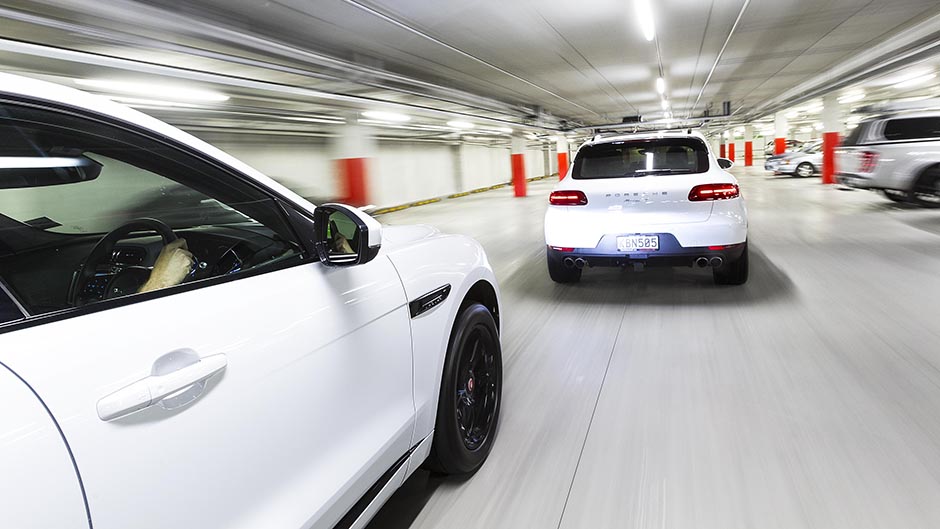
However, that’s only part of the sports mantra because getting around corners without falling off the road is of more equal importance, and that’s rather harder for a high-riding vehicle to pull off successfully. But car makers are getting a bit clever in that regard as well, and the two vehicles presented here, Jaguar’s hottest F-Pace S and Porsche’s Macan S, possess design features optimised not only for straight line running – each has forced induction and a swift shifting auto transmission – but also for mastering the art of cornering.
In the case of the Jaguar, an aluminium-intensive chassis and suspension system derived from new XF, and for Porsche optional air suspension that’s height adjustable. Both also share adaptive damping. Each costs virtually the same in base format and they share 3.0-litre six-cylinder engine formats. Being so similar in so many ways, does one end up getting the upper hand or is it a case of too close to call?
These upper-tier premium offerings cost a fair wedge of cash, both comfortably the wrong side of $100k, though in the case of the Jaguar, lesser endowed models can be purchased for under six figures. Not so the Porsche, the Macan kicking off at $125,700 for the S Diesel variant. The S petrol you see here starts out at $128,800 but we doubt you’d leave the showroom without spending more.
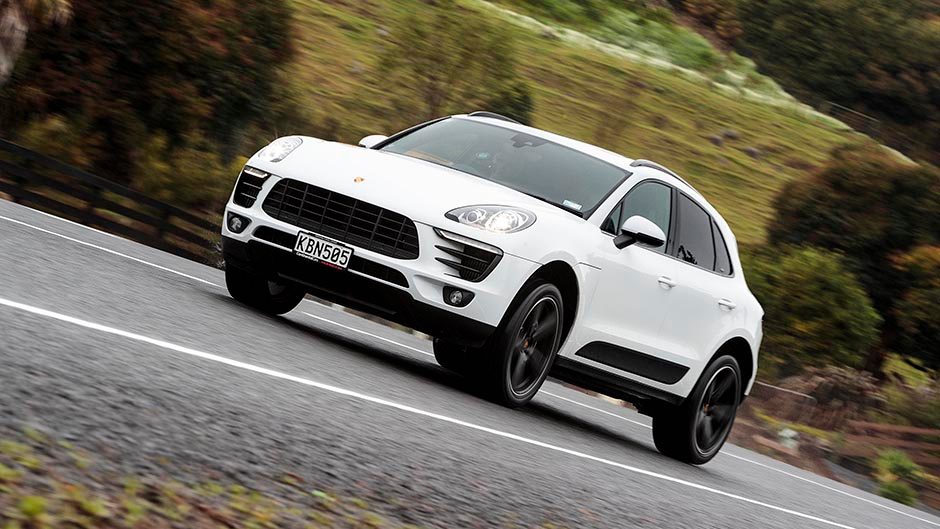
Our particular evaluation vehicle had $28,460 of extras added for a total of $157,260, enough to get you ensconced in a Cayenne diesel and yet it still didn’t sport comfort entry or push button start, both present on the F-Pace. So you need a key to lock and unlock it, and then that Panamera-shaped device has to be inserted awkwardly into a slot on the right side of the dash, and turned to effect start up.
In the Jaguar, so long as the key is nearby you can be up and gone before the Porsche owner is even belted in. Not that we’re letting the Jaguar off the hook here either, because the S is more expensive at an even $130k, and it too came healthily optioned (+$14,950 of extras). Were it me (I wish) only the $1200 20-inch alloys would get the option box tick. That said, they’re a complete steal compared with the 21-inch items fitted to the Macan ($7750).
Of all the Porsche options, we’d probably only go for the heated seats (standard in the F-Pace S) and the air suspension with PASM ($3300). Even the latter I’d mull over long and hard because we thought the steel suspension in the base diesel model was good enough to make it the best handling SUV we’d ever experienced, although that was before the F-Pace arrived on the scene. We reckon the air suspension in the Macan does add to dynamic ability, lowering the ride height as well as offering three different ride settings thanks to the adaptive damping.
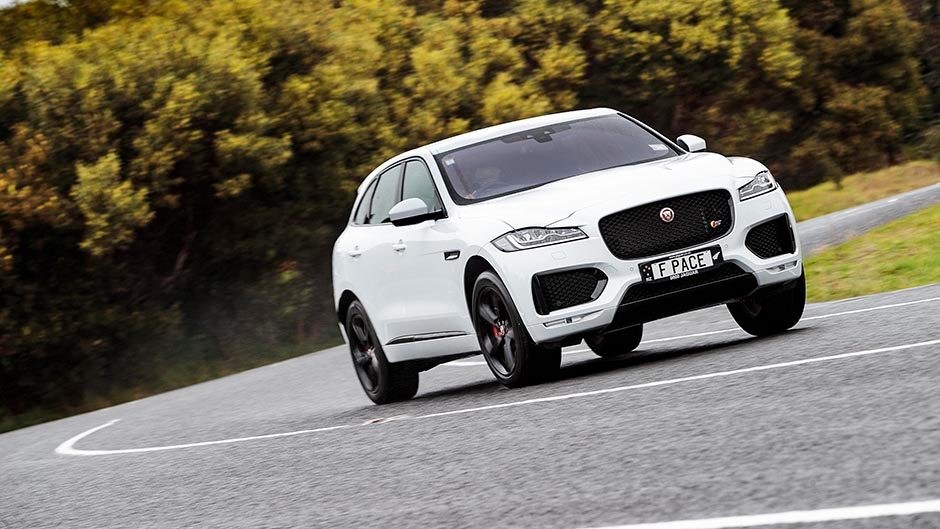
The Jaguar, it should be said, gets adaptive damping gratis. As the current top model of the F-Pace range it also comes with plenty of desirable bits, including an eight-speed auto with paddles (to the Macan’s seven-speed twin-clutch box with paddles), and torque vectoring (a cost option in the Macan). But neither has much in the way of active safety features; they’re cost extras.
Both come with cruise (not active), idle-stop devices, full leather trim, electronic parking brakes, powered fifth doors, split-folding rear seats, powered front seats with adjustable lumbar support, reversing camera with parking aids each end, dual zone climate air, nav, and alarm. Neither has a mouse controller, thankfully, both instead opting for central touch screens.
The Macan, like other Porsches, is fairly button intensive around the shift lever, but those you tend to use a fair amount, at least if you like to fiddle. You can mess with myriad engine/transmission modes, and three different degrees of ride firmness, from Comfort to Sport+. We were forever swapping between these, but in the Jaguar not anything like as much, which we shall get to anon.
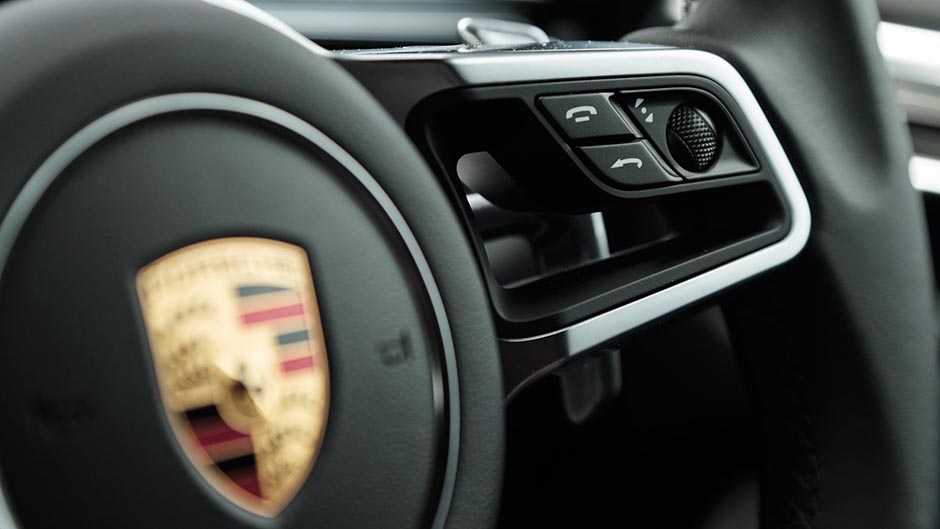
Underneath all that glamour, there are several quite important differences of which you should be aware. First, the Jaguar uses a supercharger to enliven things, the Porsche a pair of turbos, both enhancing 3.0L V6s. Power and torque outputs for the German are 250kW and 460Nm, the latter from 1450-5000rpm, while the Brit is good for 280kW, and the 450Nm arrives at 4500rpm.
Underpinning the F-Pace is JLR’s Lightweight Aluminium Architecture, bonded and riveted, apparently delivering the same structural integrity as the XF and it weighs in at just on two tonnes brimmed. The Macan utilises the Audi Q5 platform and a mix of lightweight steels and aluminium so is actually little heavier, at 2060kg, but unlike the Jaguar which sports an almost even front:rear weight split, the Porsche, with the V6 hanging in front of the leading axle is nearer to 56/44.
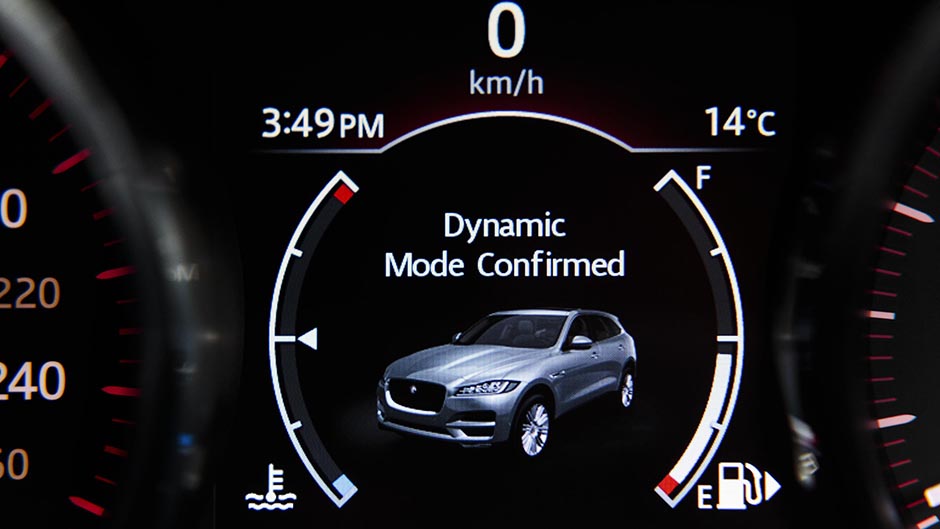
On road, it’s hard detecting that difference, though the slightly quicker turn in of the Jaguar is noticeable. During the photoshoot, admittedly done in the wet, there was no real disparity between them for best corner speeds, and during the drive, one in the dry, one not, it was hard picking differences in ability; it’s down to minor subtleties really, the steering of the Porsche with its lower profile rubber feels a touch more nuanced, and the same could be said of its marginally stronger brakes.
That said, both are at the very top of their class dynamically. Ride quality is variable in both, never harsh nor loud in either, though there’s a touch more road rumble from the Macan. It’s rather a different story on the performance front, though not so much in the acceleration figures which aren’t so dissimilar. While the two best 0-100 runs virtually overlaid one another the Porsche using launch control bolted out of the starting blocks from 5000rpm, the Jaguar from 2300rpm, so the Brit was always catching the German.
The difference was more marked on the overtake, the Macan struggling to better 4.0sec, the F-Pace finishing with a best of 3.41sec. So there’s a sense from the GPS-recorded numbers that the Jaguar is quicker.
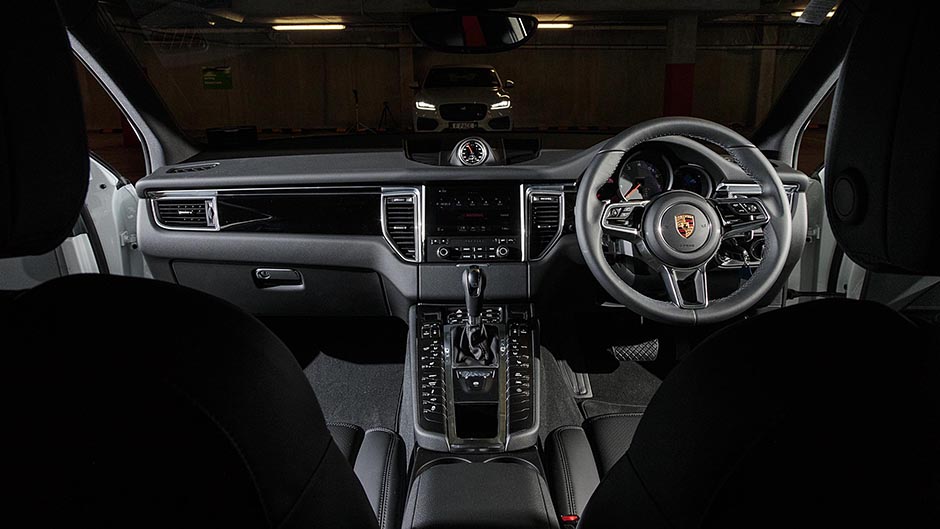
And that’s really quite apparent when you compare them in normal day-to-day running where the Jaguar surges ahead, its supercharged V6 always on the case, particularly from resting situations where idle-stop is invoked. Being turbocharged and with a dual-clutch transmission, the Macan isn’t as quick to restart, spool up and engage. The F-Pace is already a few metres gone by the time the Porsche gets off the mark.
And that’s not really the most marked difference. Even in its Normal mode, the Jaguar’s supercharger enlivens it with an eager throttle response. It takes a bit of getting used to, this instantaneous hit of power off the mark and becomes rather addictive compared with the typical (turbo) lag between application of throttle and any real action you see in some forced induction vehicles. Not that you don’t pay for it ultimately at the pump, though if you can believe trip computer figures both averaged around 11L/100km, with worst figures of about 17L/100km.
Out of town that difference in vigour is, if anything, magnified. Much of the time you’re only using revs below 3000 in the Jaguar, or perhaps 3500 tops, whereas in the Porsche at these engine speeds you’d be in no real hurry at all. It really prefers running above about 3000rpm or even 3500rpm to get the job done briskly, and the sheer strength of the Jaguar’s supercharged engine at lower engine speeds makes it much more invigorating to drive.
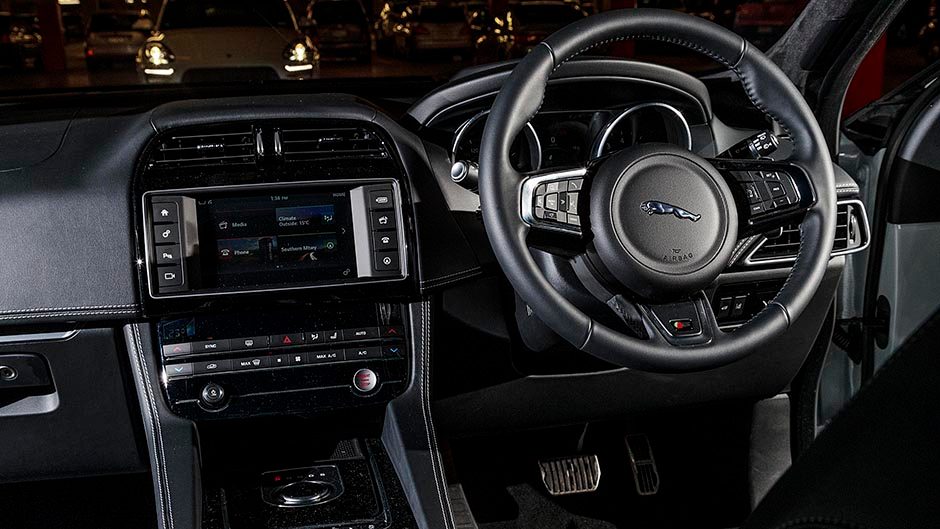
Moreover, it sounds like fun, especially if set in Dynamic mode where, I kid you not, the exhaust report resembles that of a rotary. If you’ve ever heard the shriek of an F-Type S Coupe, you’ll have some idea. The Macan, by contrast, whooshes quietly, forgettably. And while the Dynamic chequered flag setting ups the ante of the F-Pace about right, the Sport mode in Macan holds gears a bit long, so you end up paddling it along. That said, so does the Jag’s Sport transmission setting. But it is also easier to paddle, for by holding the right device it takes you back to D or S, whereas you’re stuck in manual mode with the Macan.
On the whole, I preferred the Macan drive I had a year or so ago in the S diesel over the petrol, with its more vibrant torque down low (580 vs 460Nm), and better fuel economy (6.1 vs 8.7L/100km). Evidently the diesel, which retails for $3k less sells better too.
Though the two on test here have quite different transmissions, one a seven-speed twin-clutcher, the other an eight-speed auto, both are excellent, quick-shifting devices, capable of split second multiple downshifts, and they produce much the same result in terms of quiet cruising, each loafing at 1600rpm in top at 100. Beware speed creep in each; I should know as I ran foul of the law in one of them. And if you plan on towing, braked capacity for the F-Pace is 2400kg, for the Macan 2000kg.
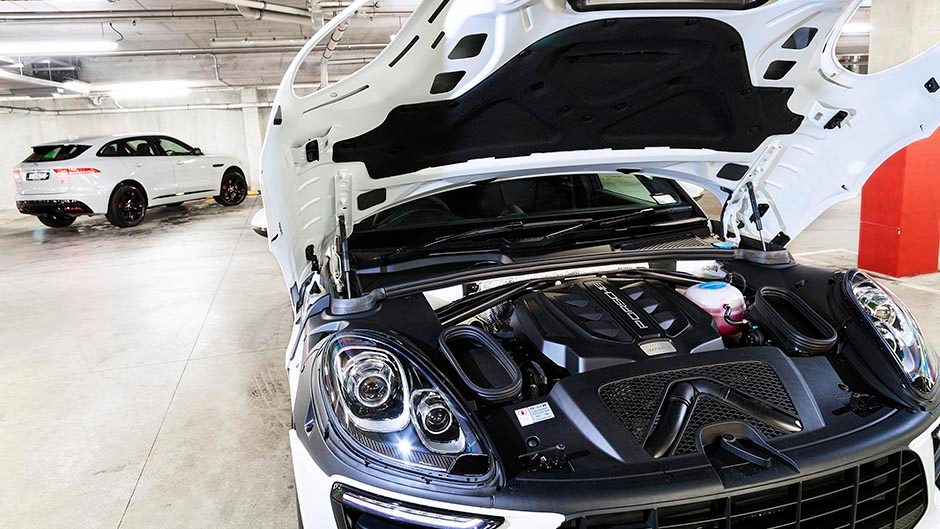
We’re getting to that, but a couple of other practical points first. The F-Pace looks and in fact is slightly the smaller of the pair. Despite that, luggage capacity is much the same at around 500L with five seats in use, but the Macan back seat passengers get less leg room. On the other hand, headroom is slightly more restricted in the F-Pace. The latter has a mid-sized spare, the Macan one that’s similar in size but needs inflating.
What seals the deal, at least from a personal standpoint, is the appearance of this pair. Both are quite aggressive, squat with big wheels, but the mini-Cayenne look of the Macan isn’t exactly innovative, while the more sloping roof, smaller glasshouse, and cooler lights on the F-Pace add menace. Jaguar nailed the look of their first SUV, along with the drive, and with a broader price spread that starts lower, it could well prove to be the best selling model in the Brit’s line-up.
Macan, meanwhile, is the people’s favourite Porsche, this year outselling Cayenne two to one, and the diesel variant the more popular (three to two) than the petrol, if you exclude the Turbo version. Of the S models, it’s the one I’d choose too.
| Model | Jaguar F-Pace S | Price | $130,000 |
| Engine | 2995cc, V6, SC/DI, 280kW/460Nm | Drivetrain | 8-speed auto, all-wheel drive |
| Fuel Use | 8.9L/100km | C02 Output | 209g/km |
| 0-100km/h | 5.38sec | Weight | 1993kg |
| Model | Porsche Macan S | Price | $128,800 |
| Engine | 2997cc, V6, T/DI, 250kW/460Nm | Drivetrain | 7-speed twin-clutch, all-wheel drive |
| Fuel Use | 8.7L/100km | C02 Output | 204g/km |
| 0-100km/h | 5.40sec | Weight | 2060kg |


